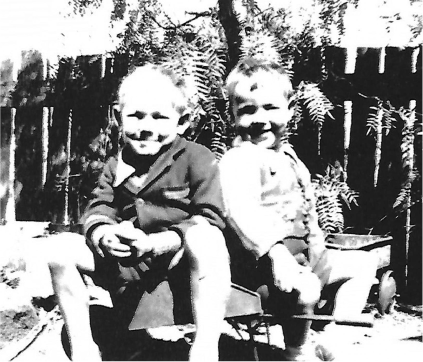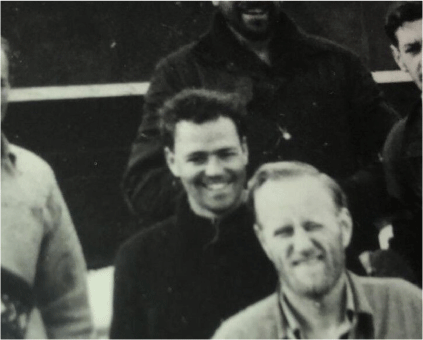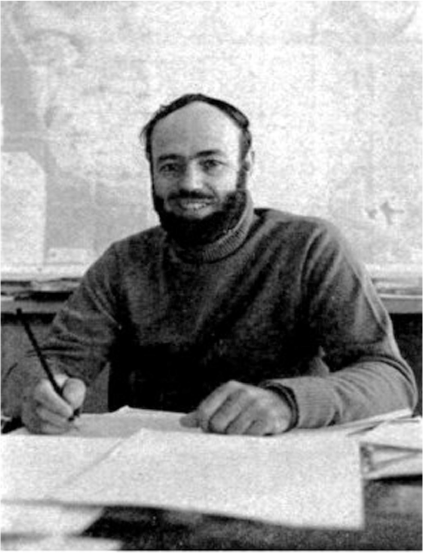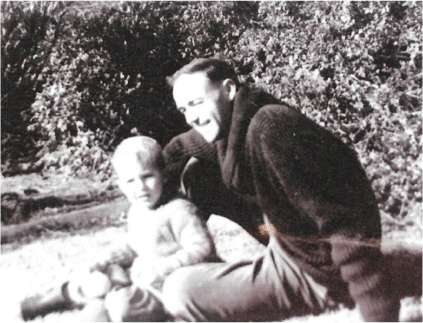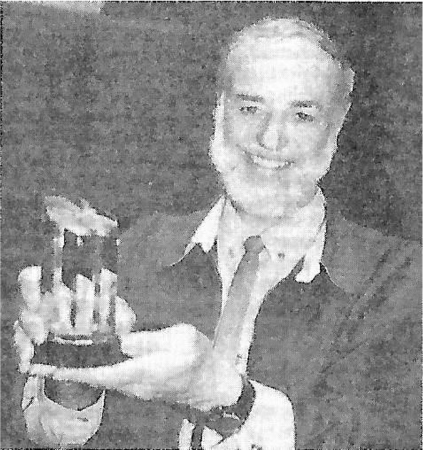William (Bill) Francis Budd 1938–2022
Ian Allison A * , Jo Jacka B and Derek Budd C
A * , Jo Jacka B and Derek Budd C
A
B
C
Abstract
Professor William (Bill) Budd was a founding figure in Australian glaciology, and the first glaciology program leader of the Australian Antarctic Division (Fig. 1). Bill worked on an enormous range of glaciological and meteorological problems covering numerical modelling of ice sheets and glaciers, including surging glaciers; ice mechanics; ice crystallography; ice core paleoclimatic studies; relationships between sea ice and climate; and katabatic wind and snow drift studies. Bill introduced and led studies of ice sheet mass budget, ice rheology, ice sheet thermodynamics, iceberg distribution and movement, drifting snow, sea ice and climate interactions and much more. He initiated Australian ice core drilling (initially for study of ice dynamics and later for palaeoclimate research), radio echo sounding of ice thickness and satellite remote sensing of ice. Much of what Bill Budd initiated more than fifty years ago remains core to the present-day Australian Antarctic glaciological research program.
Keywords: Antarctica, climate, history of science, ice sheet, memoir, numerical modelling.
Early life and education
William (Bill) Francis Budd was born on 16 October 1938 at Mount Hope, a small sheep-grazing town in the Riverina district of New South Wales, Australia. He was born in the old Mount Hope hospital, opposite the Mount Hope Hotel. Bill was the fourth of five sons of Malcolm Robert (Bob) Budd,1 and Grace Effie Cecelia Budd (née Larsen).2 His father was a local station hand working on the surrounding sheep stations doing all sorts of labouring jobs, and his mother was the Mount Hope postmistress.
Prof. Bill Budd following his election to the Australian Academy of Science in 1993. Photo credit: Australian Academy of Science.
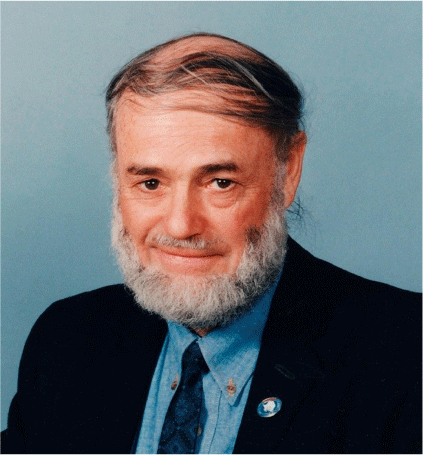
Mount Hope, located in central NSW between Hillston and Cobar, was originally established around 1870 as a copper and gold mining settlement. The mine closed around 1920 and the population declined to about 100, including a policeman, publican, shopkeeper and mechanic (Fig. 2).
Bill started school in 1944 at the one-teacher Mount Hope primary school. This had less than 20 pupils across all levels, three of whom were Bill’s brothers. They had a very good teacher in Mr Walker. Bill vividly remembered being taught to recite the poem’ My Country’ by Dorothea McKellar, because Mr Walker would draw in coloured chalk, on the whole blackboard, scenes depicting the particular verses of the poem.
With their parents both busy working, when not in school the four brothers were largely left to their own devices. Mount Hope had unlimited wide-open spaces for the boys to explore and use as their playground: an open cut mine, machinery remains, tailing dumps and underground tunnels. They shot birds and other animals with slingshots, climbed trees, and swam in the dams. The best fun was to find an old piece of sheet metal about a half metre square and slide down the face of the fine crushed rock tailing piles. It was better than any slippery-dip. Going for walks through the scrub and mallee certainly instilled a good sense of direction that would last a lifetime.
In early 1945, the family moved to Griffith, NSW, so that the eldest son, Lindsay, could go to high school. Bill started in first class of Griffith Primary School, progressing to Griffith High School in 1951. From his fourth year at high school, when subject choice became available, he started a focus on mathematics and science. Bill did very well at school—in 1955 he was appointed Boy’s Captain and was also awarded the prize for the best Leaving Certificate Pass in Griffith for that year.
At high school Bill played rugby sevens football at different age levels, culminating in his participation in the school team that won the regional open championship in 1955. He also generally did well in the school’s annual cross-country race.
Bill and his brothers gained much benefit from their modest early education and encouragement from their mother who stressed the value of education. All the brothers enjoyed successful careers because of their continued interest in lifelong learning. Lindsay Thomas (‘Buddy’, born 31 December 1932) started his career in a one-teacher rural school and finished it as inspector of schools in New South Wales following a lengthy stint as principal of Airds High School in Western Sydney. Brian Victor (‘Jit’, born 21 August 1934) left school with an Intermediate Certificate, completed a building apprenticeship, then studied architecture in Melbourne. He was a popular architect in Griffith until his retirement and his son has followed in his footsteps. Derek Robert (born 24 August 1936) followed his Leaving Certificate with an articleship to a practicing land surveyor in Griffith. After his registration, Derek became a partner in a surveying practice that is now the largest rural surveying firm in New South Wales. The fifth son, Danny Malcolm (born 1 September 1946, after the family had moved from Mount Hope) recently retired after running a successful accountancy practice in Griffith. He was an avid punter and bookmaker for over thirty years.
Undergraduate education
In 1956, Bill won a New South Wales Department of Education scholarship to the University of Sydney to undertake a basic science degree, majoring in applied mathematics. Money was tight, so Bill shared a room in a private boarding house in Enmore with his brother, Derek, who was working in Sydney as a trainee surveyor. Bill rode his bike to university every day down Newtown Road when it was crowded with trams and the tram tracks were fraught with danger in wet weather. During university vacations from 1956 to 1959, Bill would go back to Griffith and work in local produce factories, or with his father in the shearing sheds. By the time he graduated, Bill was an excellent roustabout and could throw a fleece with the best of them. He also learnt basic surveying skills from Derek.
Bill’s undergraduate studies were coincident with the 1957–8 International Geophysical Year (IGY). The chair of the Sydney University Department of Applied Mathematics at that time was Prof. K. E. Bullen, whose text books An Introduction to the Theory of Mechanics and An Introduction to the Theory of Seismology were used in applied mathematics courses. The latter, in particular, gave Bill a sound background for the work he would undertake on over-snow traverses in Antarctica. Keith Bullen was well known for his work with Harold Jeffreys, of the University of Cambridge, on the structure of Earth from seismology. Bullen was involved with the international planning of the IGY and became the vice-president of the International Council of Scientific Unions’ committee on Antarctic research (1958) and the first chairman of the Australian National Committee for Antarctic Research (ANCAR) of the Australian Academy of Science (AAS). Bill Budd would follow in Bullen’s footsteps in both these positions, 25–30 years later.
After graduating with a BSc, Bill completed a Diploma of Education in 1959 and undertook a short course of (mandatory) National Service Training in the Australian Army Infantry Corps.3 He would later describe how Army training mostly taught him how to paint rocks white. In 1960, he commenced teaching mathematics and science at Farrer High School, New South Wales. But when an advertisement appeared for expeditioner positions with the Australian National Antarctic Research Expedition (ANARE), including positions in geophysics and glaciology on ice sheet traverses inland of Wilkes station, Bill applied. He was interviewed and selected by Phillip Garth Law, then head of the Antarctic Division, the government body that organised ANARE.4
Glaciological field research in the Antarctic
Dr Fritz Loewe and Dr Uwe Radok at the University of Melbourne, Department of Meteorology, promoted and supervised glaciology within ANARE during this period. Loewe was one of the pioneers of glaciology and meteorology.5 He had been deputy-leader of the 1930–1 German Greenland Expedition of Alfred Wegener, on which Wegener died. Loewe had wintered in an ice cave in central Greenland with two others under extremely arduous conditions (he amputated his own frostbitten toes). He had also wintered in Antarctica at Port Martin with the French in 1951.
Uwe Radok was Bill’s principal mentor. Radok had been an engineer, born in Germany, and was living in the UK when World War 2 broke out. Declared an ‘enemy alien’ he was deported, eventually to Australia,6 on the ship Dunera. Known as the ’Dunera Boys’, these deportees consisted of many well-educated men (stimulating regular and serious discussion) who were interned in two camps within Victoria and New South Wales.7 Eventually, Radok, who had a keen insight into a wide range of glaciological and meteorological topics, was able to secure a position with Loewe at the University of Melbourne and together, they went on to establish the ANARE glaciology program on a firm foundation.
Wilkes (66.26°S, 110.53°E) had been established by the United States in 1957 for the IGY and was handed over to Australia in February 1959. The Americans had commenced studies of ice dynamics on the local ice cap (now called Law Dome) and of the fast-moving Vanderford Glacier, 25 km south of Wilkes. Bill’s 1961 field work built on these, but also included participation in an inland traverse, south from the local ice cap onto the main East Antarctic Ice Sheet, that ventured 460 km from Wilkes, further than any previous expedition (Fig. 3). As glaciologist, Bill undertook detailed barometric levelling, measurements of snow accumulation rate and borehole snow temperature profile measurements to 10 m depth along the traverse route. Gravity measurements and seismic soundings about every 30 km, using the temperature boreholes, were made by the expedition geophysicist. Bill also continued studies commenced by the Americans, of ice deformation in a 60 m-deep pit and tunnel in the ice, 80 km inland of Wilkes; and he undertook detailed studies, designed by Radok, of snow drift and blizzards.
Bill estimated that he spent nearly two-thirds of his time at Wilkes in the field.8 He trained Steve Grimsley, the 1961 ionospheric physics technical officer, to continue routine measurements of ice movement markers from Wilkes while he was away from base (Fig. 4).
Bill (right) instructing Steve Grimsley how to use a theodolite to continue the ice movement measurements at Wilkes during his participation in the inland traverse. Photo credit: Steve Grimsley.
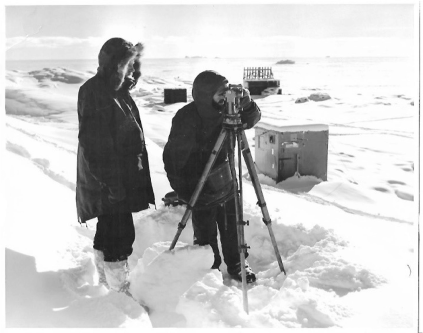
On his return to Melbourne, Bill spent the next twenty-one months, under guidance from Radok and Loewe, analysing the data from Wilkes and compiling them as a thesis for a Master of Science degree. He had by this time gained considerable practical experience with the properties of the ice sheet, accumulation and ablation processes, snow drift, meteorology and climate of the Antarctic, and ice sheet and outlet glacier dynamics. But he had not yet investigated the large, floating ice shelves which fringe about 40% of the Antarctic coastline and are a major path for the outflux of Antarctic ice to the Southern Ocean. He planned, with Radok and the Antarctic Division, the Amery Ice Shelf study as a three-year program investigating ice shelf characteristics and dynamics based out of Mawson station. The initial measurements on the Amery Ice Shelf were made by other glaciologists in 1962 and 1963. In 1964, Bill then headed back to the Antarctic for a year at Mawson (67.60°S, 62.87°E) to complete the Amery measurements. This was before his MSc thesis was completed, but it was successfully submitted shortly after his return from Mawson.9
Bill was one of twenty-six men who overwintered at Mawson in 1964 (Fig. 5). Roger Francey (cosmic ray physicist, Mawson 1964; who became a leader of CSIRO studies of greenhouse gases) remembers Bill as a constant source of inspiration to him, as a young and inexperienced scientist. Bill’s work program was ambitious and intense, his demeanour unfailingly cheerful, insightful, encouraging, and polite. Rodger Williams (radio technician, Mawson 1964) remembers that Bill had a good sense of humour and did not mind a chat when he was not working on his glaciology program or Amery Ice Shelf planning. He was a good talker and storyteller. He had boundless energy and was a voracious eater—which was probably why he had so much energy.
The 1964 Mawson party. Bill is in the centre in a dirty hooded parka and with his trademark grin. Photo credit: AAD.
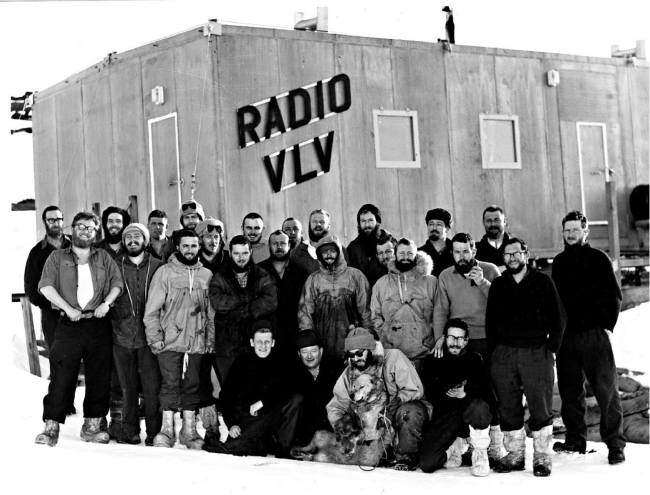
Bill initially worked locally near Mawson on climatology, ice ablation, snow drift and accumulation, sea ice thickness and extent, and on planning the Amery Ice Shelf survey of ice velocities, strain rates, temperatures, snow accumulation, surface elevation and ice thickness (Fig. 6). A five-week traverse in autumn travelled east from Mawson and established a fuel depot 35 km west of the Amery. Then, between October 1964 and January 1965, Bill was part of a five-man party with two seven-ton D4 Caterpillar tractors, two 2.5-ton Weasel tracked vehicles, and an early model snowmobile that undertook the main ice shelf measurements. The D4 tractors were left at the autumn depot, the two Weasels were offloaded and travelled down to the ice shelf and across to a longitudinal centre-line of survey stakes established in the previous year. During six weeks, the party surveyed the longitudinal stake line and two transverse lines, lived in the Weasels except when they travelled by snowmobile and slept in polar pyramid tents. They resurveyed the whole network of stakes and extended it longitudinally 30 km towards the ice shelf front. They also tried to measure ice thickness with an early aircraft radar altimeter, but were unable to get good echoes. Returning to the tractors at the depot, they travelled 400 km non-stop to Mawson, plagued by bad weather and taking four weeks to get back.10 In all, the party had travelled a total distance of 1600 km in eleven weeks.11
Bill Budd preparing a dog sledge for the 1964 spring/summer trip to the Amery Ice Shelf. Photo credit: W. Budd/AAD.
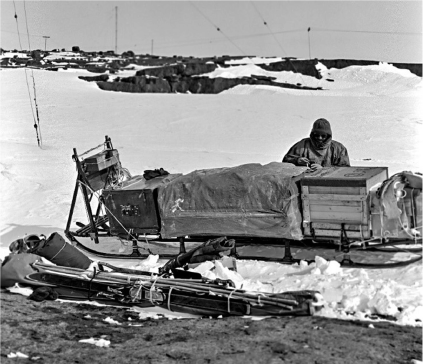
Although he continued to lead, plan, and supervise Australia’s Antarctic glaciology program until 1979, this was Bill’s final visit to an Australian Antarctic station. He did however visit the Antarctic again in January 1985 with the United State program when the United State’s delegate to the Scientific Committee on Antarctic Research (SCAR) arranged a workshop to discuss and assess the efficacy of the Antarctic Treaty System. This took place at a research camp near the Beardmore Glacier, 660 km from the South Pole. It was attended by 57 diplomats and top Antarctic scientists, including Bill Budd, from twenty-five countries. Bill also briefly visited McMurdo and Amundsen-Scott South Pole stations during this trip.
Developing and growing the Australian glaciology program
On his return to Melbourne in March 1965, Bill continued working for the Antarctic Division at the University of Melbourne Meteorology Department (UNIMET), analysing his Antarctic field data and jointly planning and supervising ANARE glaciological field programs with Uwe Radok. He travelled briefly to New Zealand, to collaborate in a field study of glaciers in the Mount Cook region. He also began work on a PhD which was based on the measurements and observations from his two Antarctic expeditions, combined with his uncanny knack for developing ideas and for translating physical observations into mathematical theories. The PhD was awarded in 1968, and a year later was published as an ANARE Research Report entitled The Dynamics of Ice Masses.12 This publication was regarded as the most advanced glaciology text at the time, was translated into Russian, and was used by many glaciology teachers worldwide.
In 1968, the Australian Antarctic Division formally established a Glaciology Section which was located at the University of Melbourne, where it worked in close collaboration with the Meteorology Department. Bill was appointed to a full-time position as the head and became responsible for developing and supervising the ongoing field studies which included a multi-year continuation of the Wilkes studies as the Wilkes Ice Cap Project. He used data from these programs to validate his further development of the mathematics of ice dynamics to include longitudinal stress and strain gradients in ice sheets,13 and ice flow over bedrock undulations.14 This development was inspired by his observations during the 1961 inland traverse from Wilkes that relatively large and fairly regular surface undulations (~30 m × 10 km) were superimposed on the smoother large-scale ice cap curvature, and that some of the undulations were so large that the ice was actually flowing uphill.
In 1971, Bill was funded by a Fulbright Fellowship to undertake a four-month visit to about twenty centres of glaciological research in North America and Europe, and he also visited research sites in Greenland and the Canadian Arctic. The main focus of his visit was to collaborate with the strong Arctic sea ice and glacier groups at the University of Washington and the US Geological Survey in Seattle. Bill developed further lasting collaborative links when, in 1973, he spent several months as a Visiting Fellow at the Scott Polar Research Institute, University of Cambridge.
As a section head within the Antarctic Division, Bill rapidly expanded the size and activity of the Australian glaciology program. From about 1970 he obtained Divisional funding to extend the employment of some of the returned expedition glaciologists on a rolling basis and, also in 1970, he employed an ongoing Technical Assistant. He also recruited postgraduate students to work on computer modelling of glacier and ice sheet dynamics and laboratory studies of ice mechanics and employed casual student assistants. By 1980 the glaciology group at UNIMET, including University staff and students, had grown to more than fifteen.
The Amery Ice Shelf project and the International Antarctic Glaciology project
To extend the 1962–4 Amery Ice Shelf program, Bill developed a comprehensive further survey using the latest technology, including Electronic Distance Measurement (EDM) and a thermal ice-coring drill. In 1968, a four-man team led by surveyor Max Corry, spent the winter on the Amery Ice Shelf undertaking glaciological studies under very difficult living conditions. They successfully drilled into the shelf and recovered a 327 m continuous vertical ice core, surveyed the ice shelf to measure horizontal movement and surface elevation, and made micrometeorological measurements at their base. Bamboo canes along the survey lines were replaced with metal poles which were easier to locate using navigational radar. The poles were resurveyed in the 1969/70 summer and the ice shelf thickness along the pole lines was measured with the first successful Australian use of ice-sounding radar. They found that near the calving front, the ice shelf was moving at 1.2 km/year, at the southern inland end at about 380 m/year and on (what was then thought to be the grounding line where the ice shelf started floating)15 the ice flowing into the Amery from the Lambert Glacier system was moving at 150–250 m/year. Following the 1968/69 summer resurvey, the Amery was probably then the most studied and mathematically described ice shelf in Antarctica.16
In 1968, the SCAR Working Group (WG) on Glaciology and the International Association of Scientific Hydrology Commission on Snow and Ice convened the International Symposium on Antarctic Glaciological Exploration (ISAGE) at Dartmouth, USA. This conference, which was attended by Radok (chair of the SCAR WG at the time) and Budd, reviewed the significant developments that had been made over the previous decade and also hosted meetings to plan future field programs, particularly in the data-sparse region of East Antarctica between 90° and 160°E. This developed into the International Antarctic Glaciological Project (IAGP), a multi-nation SCAR-backed project involving large-scale over-snow traverses, airborne radio echo-sounding and ice core drilling.17 It aimed to determine the glaciological regime and processes of a major part of East Antarctica, to estimate the ice sheet mass balance and to facilitate interpretation of deep ice core climate records, then starting to become a major source of palaeoclimate data.18 The initial IAGP collaborators were Australia, France, UK, USA and USSR, later joined by Japan.
Bill planned and supervised ANARE field contributions to IAGP (Fig. 7). Between 1971 and 1979, a series of oversnow traverses were made along the East Antarctic Ice Sheet flow line inland from Casey.19 These were followed between 1980 and 1986 by traverses to the east and west of the flowline route, approximately following the 2000 m surface elevation contour. Accurately locating the position of markers to determine the ice surface velocity was initially by triangulation with theodolite and EDM. This was superseded in 1973 with satellite location using the Transit (NAVSAT) doppler navigation system. In 1973, the doppler receiver was operated by a group from the United States Geodetic Survey, but the Australian program later obtained its own receivers and operated these on the surveys out of Casey as well as on summer IAGP traverses of the USSR, between 1976/77 and 1983/84, from their coastal station Mirny to Dome C, high on the ice sheet interior.20
Development of the first ice sheet and glacier numerical models
Uwe Radok was at the forefront of the development of Numerical Weather Prediction (NWP) in Australia. When Dick Jenssen, who had developed a finite-difference solution to the barotropic model for his MSc,21 joined the Meteorology Department staff in 1965, UNIMET developed strong expertise in NWP and computational techniques.22 Radok and Jenssen also developed a scheme for computing transient temperature-depth profiles in ice sheets and ice shelves. By the mid-1960s, with increasing computer power and availability of the first interpolated data sets for the whole of Antarctica, Bill Budd joined Radok and Jenssen to extend the single-column analysis to whole flowlines utilising the ice sheet physics developed in The Dynamics of Ice Masses.
Budd, Jenssen and Radok went on to model the whole Antarctic Ice Sheet. This was done on the then new University of Melbourne IBM7044 computer (with a capacity of 64 K bytes). The computer language used was FORTRAN IV. Data input was by punch cards and output was printed on A0 (4 × A4) paper, with results manually plotted and contoured. With the very limited (by today’s standards) capacity of the computer, the only way the whole Antarctic Ice Sheet could be modelled was one ice flow line at a time. Flow line positions were drawn manually, perpendicular to surface elevation contours and selected where possible, to pass through locations where data from field measurements were available. The final publication included an envelope in the back cover containing contour maps of each input and output parameter (thirty-six maps in total) and was the first comprehensive analysis of the whole Antarctic Ice Sheet.23
Following this, Bill and his colleagues went on to repeat the exercise for the Greenland Ice Sheet.24 Other modelling studies included accurate calculations of the temperature profile through ice sheets and estimation of climate change from the difference between measured and modelled steady-state profiles.
In 1971, on Bill’s return from his Fulbright Fellowship in Seattle where he had studied early developments of three-dimensional glacier modelling, he and Dick Jenssen adapted their ice sheet flowline model to ordinary temperate glaciers. Their objective was to model a large number of ordinary glaciers as a prelude to modelling surging glaciers. This was later extended, with post-graduate students, to investigate transient responses of glaciers and to deduce the climate changes inducing them. Bill developed a first simple model of periodically self-surging alpine glaciers,25 and extended this with colleagues to investigate the surging potential of ice sheets and the consequences for rapid sea level rise.
During the mid-1970s, Bill added to his repertoire the use of atmospheric general circulation models for climate studies and climate/ice sheet interaction and response studies. These were to become a major focus of his future work.
Fundamental physics of ice flow
At the same time as the modelling progressed, Bill Budd, colleagues and students were also carrying out laboratory experiments and field (ice borehole) studies to understand the fundamental physics of ice flow, primarily aimed at improving the models. A paper he published in 1972 was at the forefront of the understanding of relationships between ice flow and ice crystal structure.26 This paper set the foundations for further detailed examinations of these relationships, and initial experiments established the concept of minimum ice creep rate for ice with a random distribution of crystal orientations, occurring at about 1% strain, and later, of steady state creep, established after the development of a preferred crystal orientation pattern dependent on the stress configuration. A later major review paper of ice rheology for sheet modelling detailed the state of the science at that time,27 and since then further applications have led to vast improvements in the ice sheet models.
When UNIMET shifted location on campus, Bill ensured that there were adequate cold room facilities and ice core laboratories in the new Earth Sciences Building. He maintained a strong interest and involvement in ice rheology long after his formal retirement.
Continuing and expanding ice-climate research within the university sector
In 1979, a new Chair of Meteorology, for which Radok had been fighting for many years, was established at Melbourne and Bill resigned from the Antarctic Division Glaciology Program to become the first Professor of Meteorology at the university. He was able to retain his strong links with the glaciology program.
Ian Simmonds had been recruited to the UNIMET group in 1977 as a climate modeller, shortly before Bill took over as Professor. Together they led the effort to improve model performance, particularly in the polar regions. This made it possible to carry out a wide range of climate experiments. The work of Budd, Simmonds and Jenssen and their post-graduate students through the 1980s included modelling of ice sheet changes through ice ages, incorporation of sea ice processes into global climate models to study the role of sea ice in the climate system and in atmosphere-ocean feedbacks, and general circulation modelling assessments of climate change and Antarctica’s response to future global warming.
As chair of the Department of Meteorology, Bill was also responsible for management functions of the department, and also for some of the period, for those of the whole School of Earth Sciences. He continued to serve on international committees requiring extensive travel. Financial and administrative pressures increased within the University of Melbourne, and there was a move for Meteorology and Glaciology to lose their separate identity within a merged School of Earth Sciences. Bill hence welcomed the opportunity when, in 1992, the new Cooperative Research Centre for the Antarctic and Southern Ocean Environment (known as the Antarctic CRC) was established in Hobart. The Antarctic CRC was a research collaboration between the University of Tasmania, CSIRO Marine Science, Australian Antarctic Division, Geosciences Australia and the Bureau of Meteorology, with substantial additional funding provided by the Australian Government’s Cooperative Research Centre Program.
Together with some of the other meteorologists, Bill transferred from Melbourne to become Professor of Meteorology at the University of Tasmania, Institute for Antarctic and Southern Ocean Science (IASOS) and leader of the Polar Atmospheres Program in the Antarctic CRC. The Glaciology Section of the Antarctic Division was also moved to Hobart, where its parent organisation had been for a decade, to become part of the new CRC. So not only were collaborations that had been so strong for more than twenty years able to continue, but new collaborations were established, and new staff positions and facilities became available from the dedicated CRC funding. Bill oversaw the scientific direction of this expanded capability and was an active participant in the Ice Sheet Mass Budget, Ice Cores/Palaeoclimate and Sea Ice Programs of the CRC. He continued to work on an enormous range of problems, especially those involving ice sheet and sea ice modelling and ice/ocean/atmosphere-coupled modelling.
In Hobart, Bill’s work on modelling the response of the Antarctic to future warming and on the role of Antarctic processes on atmospheric CO2 and global sea level expanded in collaboration with new CRC staff and post-graduate students. The sea ice modelling research continued with Ian Simmonds, who remained in Melbourne, developing a fully interactive dynamic and thermodynamic sea ice model which was subsequently used for a wide range of sea ice and climate sensitivity studies. These were informed by and validated against the comprehensive new Antarctic sea ice observational program instigated within the CRC.
In 1997, the CRC, renamed the Cooperative Research Centre for Antarctica and the Southern Ocean, was funded for a second term. Bill continued to lead atmospheric and climate research within the CRC and served as its interim director and CEO towards the end of this term. He played a major part in the successful bid for a third term (as the Antarctic Climate and Ecosystems (ACE) CRC).28 Bill formally retired in 2005 but continued his research interests and as a research-supervisor of post-graduate students.
In 1998, Bill was part of a consortium funded to use high performance computing for strategic research, which led to the establishment of the Tasmanian Partnership in Advanced Computing (TPAC) in 2000. In 2004 he was funded, in collaboration with colleagues, to examine the role of cloud seeding for improving rainfall over water catchments in the southwest of Tasmania. Later in a collaboration led by Professor Nathan Bindoff and with CSIRO and commercial partners, he contributed to the first downscaled simulation of regional climate change. This project was the forerunner to the very successful Climate Futures Tasmania program (2008–11) which redefined understanding of climate impacts on water catchments, extremes (including bushfires) and agriculture as well as general climate change. Bill was at the forefront of novel climate change impact research.
In between the major phases of Bill’s scientific work were numerous studies, both of a fundamental and applied nature. These included empirical studies of ice sliding; satellite remote sensing of sea ice; the distribution, movement, and melt rates of icebergs; the compaction of snow to construct aircraft runways; the relationships between sea ice extent, Southern Hemisphere atmospheric and oceanic circulation, and climate; and modelling of the northern polar ice cap of Mars.
Overall, in both Melbourne and Hobart, Bill supervised more than forty postgraduate students.29 He was constructive, generous and supportive to them, and to the many other early career researchers that he also mentored. Bill had a knack of contributing to the development of scientific interpretations in a very subtle way. He would take great interest in emerging and young scientists by listening to their ‘new’ theories, observations or plans for future field work. His mentoring often led to scientists seeing the problem and the solutions from an entirely new angle. This is something that underpins many of his graduate students’ careers.
Bill Budd the person; family and private life
In 1964, Bill married Patricia (Trish) Yvonne Grant. She was born in Collie, Western Australa and later moved north to Geraldton. Their two sons, Malcolm Francis Budd and Cameron Grant Budd, were born in Melbourne in March 1964 and July 1972 (Fig. 8). The family lived in the eastern Melbourne suburb of Box Hill. Both boys attended the local Koonung Heights Primary School and then Koonung High School. Malcolm then completed a BAppSc (urban design) at RMIT University in Melbourne while Cameron switched from high school to Box Hill TAFE, undertook a plumbing apprenticeship and became a licensed plumber.
Bill initially commuted to the University of Melbourne from Box Hill in his Volkswagen ’beetle’. But in the early 1970s he upgraded and acquired a second-hand Porsche 912. The 1970s 912 looked almost identical to a Porsche 911, but had a far less powerful four-cylinder VW-based engine. After a couple of years, Bill exchanged this for a Datsun 260Z coupe, which he still drove when he initially moved to Hobart in 1992.
On moving to Tasmania, Bill and Trish purchased a house on 2 ha of land on Old Bernies Rd., Margate, south of Hobart. This was in an area colloquially known, from the Great Depression days, as Poverty Gully. They also bought a nearby 15 ha rural block of land and grazed about 6 Hereford beef cattle and 15–20 sheep. Bill commuted 22 km to the University of Tasmania and Trish worked for a telecommunications company in New Town, north of Hobart city. Cameron moved to Tasmania in the mid-1990s to live with his parents in Margate. Malcolm worked in the Police Forces in Western Australia and the Northern Territory. In 1998, he and his young family also transferred to Hobart and bought their own house. He completed a graduate Diploma of Environmental Studies at the University of Tasmania and changed career, becoming an Environmental Planner in the State Government Department of Primary Industries, Parks, Water and Environment.
Bill was not usually a person who joined social organisations. He used to quote Groucho Marx, stating ‘I wouldn’t want to join any organisation that would have me as a member’. But he was a foundation member of the ANARE Ski Club, which built a club lodge at Mt Baw Baw, east of Melbourne in the late 1960s. Bill was never an enthusiastic skier and tended to work on scientific papers in the warm lodge, but his sons Malcolm and Cameron both became accomplished skiers from their early introduction and coaching.
Bill had a unique office filing system. Nothing was ever methodically filed, but instead, everything (letters, books, manuscripts, reprints, and so on) was simply added on top of the existing pile on one of the many horizontal surfaces in his large office. These were all piled to the critical angle of repose. But Bill had a remarkable ability to find anything within these many piles. If you requested a copy of a 1980 paper by Smith and Jones, he would twirl the end of his beard for twenty seconds before heading to one of the piles, thrusting his hand into the middle of the pyramid, and pulling out the requested paper.
While globally renowned as an ice and climate modeller, this reputation was for his ability to develop links between physical observations and mathematical formulation, not for his practical computer or programming skills. His colleagues had serious doubts that Bill even knew how to turn a laptop on, or how to access email (let alone use a mobile phone): although he was always well aware of the latest technological advances in computing technology and capacity. In Hobart, his secretary/personal-assistant would print copies of incoming emails and give them to Bill. He would compose his response (in pencil) perched on a chair (there was never a free horizontal surface to lay the paper on) and return it to the secretary to type and send off electronically.
Service and awards
Bill Budd was active in international scientific collaboration throughout his career and was in great demand for service on many councils, committees and advisory bodies. He was involved in initiating the International Antarctic Glaciological Project (IAGP) in 1968, and in steering its implementation as a member of its council from 1972 to 1986. He served for many years as a member of the SCAR Working Group on Glaciology; was founding Convenor of the SCAR Group of Specialists on Sea Ice; and was a SCAR vice-president from 1988 to 1992. He made considerable input to many other international and national organisations, including as a member of Council of the International Glaciological Society; to the Global Atmospheric Research Programme and the World Climate Research Programme; to the International Commission on Snow and Ice and the International Commission on Polar Meteorology; and as vice-president (1981–2 and 1985–7) and president (1983–4) of the Australian Branch of the Royal Meteorological Society.
Bill Budd’s international reputation for the development of ice sheet and climate modelling has been widely recognised by many awards and honours. These include the Polar Medal in 1969, the Edgeworth David Medal of the Royal Society of New South Wales in 1971, the Royal Society of Victoria Research Medal (Physical Sciences) in 1977 and the R. M. Johnston Memorial Medal of the Royal Society of Tasmania in 2001. In 1996, Bill was awarded the Seligman Crystal, the highest scientific recognition of the International Glaciological Society (Fig. 9):
as a unique person, an original thinker with a far-ranging mind, a theoretician as well as a practical field scientist, who has made major scientific contributions in many glaciological areas, ranging from the ice caps of Mars to sea ice, glaciers, and ice sheets of both polar regions on Earth.30
In 1993 Bill Budd was elected as a Fellow of the Australian Academy of Science. The short citation on his election read:
For three decades Professor Budd has played a dominant role in international research on polar ice. Based on extensive practical experience in Antarctica, he has produced theories and experimental confirmation of the large-scale behaviour of ice which he and his colleagues have used to study the interaction of ice sheets and climate. His models provide explanations for the initiation and passing of ice ages, and simulate the response of Antarctica to future global warming. His experimental analyses of ice flow provide essential background for the study of ice core proxy records of past climate. In general, his work unlocks many of the polar region keys to global change.
Bill was involved in academy activities both before and after he was elected as a Fellow. This included more than 35 years’ membership, between 1964 and 1999, of different committees of the Australian National Committee for Antarctic Research (ANCAR). He was a member of the over-arching ANCAR committee (1976–88 and 1993–9) and chair from 1983 to 1988. The latter position also gave him an ex-officio position on the Australian Government’s Antarctic Research Policy Advisory Committee (1984–5). He served continuously on the ANCAR Glaciology sub-committee between 1964 and 1995, and was chair from 1972 to 1983. He also served on many other disciplinary sub-committees of ANCAR, often serving on several sub-committees at the same time. Bill also served multiple terms on other Academy National Committees including Geodesy and Geophysics, Climate and Atmospheric Sciences (including 10-years on the sub-Committee for the World Climate Research Programme), and Oceanic Science. He was a member of the AAS Sectional Committee 4 (Solid & Fluid Earth & Planetary Science) from 1995 to 1999, and its chair from 1997 to 1999.
Summary
Professor Bill Budd was a visionary scientist, a superb mentor and a fascinating individual. He was expert in glaciology, meteorology, climatology and even atmospheric chemistry. Commencing with his initial field studies of Antarctic ice dynamics in the early 1960s, he went on to develop the fundamental basis of the flow and mass balance of the Antarctic Ice Sheet. This ultimately led to a sound framework for understanding the interactions between ice masses and climate and the role played by Antarctica and the other large ice sheets in the global climate system. This further led to a basis for understanding the waxing and waning of the ice ages by explicit numerical modelling of the North American Ice sheet and independent modelling of the global climate.
From the 1990s on, Budd and his colleagues also progressed the study of future climatic change with particular emphasis on the role of the Antarctic. This extensive work covered monitoring of recent climatic changes, modelling of future changes to the atmosphere/sea ice/ocean system and to the ice sheet, and its contribution to sea level change. The results of this work have been extensively used in international assessments of future climate change—most notably by the Intergovernmental Panel on Climate Change (IPCC).
Bill Budd has been and continues to be a major influence in the study of glaciology and climate processes in Australia and worldwide. He dedicated his life to scientific progress and to the development of the next generation of scientists. He was a multidisciplinary scientist, equally at home in meteorology, glaciology, atmospheric chemistry, and many other fields. He was quick to recognise and adopt new technologies that would advance scientific understanding. He was also knowledgeable and very comfortable over a wide range of subjects including politics, law and history. Although he enjoyed significant academic success, he was always a very quiet and humble person.
Emeritus Professor William (Bill) Francis Budd died contented and peacefully on Sunday 23 January 2022. In his true form, Bill donated his body to science. His wisdom and wit will be remembered by his wife and sons, and his many friends and colleagues. His legacy will continue to benefit the many research programs that he initiated, and which continue today.
Data availability
No new data were generated or analysed during this study and data sharing is not applicable.
Acknowledgements
The authors are grateful to many of Bill’s colleagues and friends who provided comments and insight to his work and character that significantly improved this memoir. These include, but are not limited to, Nathan Bindoff, Ian Bird, Christie Budd, Malcolm Budd, David Etheridge, Roger Francey, Stephen Grimsley, Wennecke ten Hout, Adam Treverrow, Roland Warner and Rodger Williams.
References31
Anonymous (1976) Profile: Dr W. F. Budd, Ice (Newsletter of the International Glaciological Society), 51, 10-11.
| Google Scholar |
Antonello, A. (2018) Glaciological bodies: Australian visions of the Antarctic ice sheet, International Review of Environmental History, 4(1), 125-144.
| Crossref | Google Scholar |
Bentley, C. R., Budd, W. F., Kotlyakov, V. M., Lorius, C., and Robin, G. d. Q. (1972) The international antarctic glaciological project standardisation document, SCAR Bulletin, 41, 853-868.
| Google Scholar |
Bourke, W. (2021) Pioneering of numerical weather prediction in Australia: Dick Jenssen, Uwe Radok and CSIRAC, Proceedings of the Royal Society of Victoria, 133, 67-81.
| Crossref | Google Scholar |
Budd, W. F. (1970a) The longitudinal stress and strain-rate gradients in ice masses, Journal of Glaciology, 9(55), 19-27.
| Crossref | Google Scholar |
Budd, W. F. (1970b) Ice flow over bedrock perturbations, Journal of Glaciology, 9(55), 29-48.
| Crossref | Google Scholar |
Budd, W. F. (1972) The development of crystal orientation fabrics in moving ice, Zeitschrift für Gletscherkunde und Glaziolgeologie, 8(1–2), 65-105.
| Google Scholar |
Budd, W. F. (1975) A first simple model for periodically self-surging glaciers, Journal of Glaciology, 14(70), 3-21.
| Crossref | Google Scholar |
Budd, W. F., and Jacka, T. H. (1989) A review of ice rheology for ice sheet modelling, Cold Regions Science and Technology, 16, 107-144.
| Crossref | Google Scholar |
Budd, W. F., and Young, N. W. (1979) Results from the IAGP flowline study inland of Casey, Journal of Glaciology, 24(90), 89-101.
| Crossref | Google Scholar |
Budd, W. F., Corry, M. J., and Jacka, T. H. (1982a) Results from the Amery Ice Shelf project, Annals of Glaciology, 3, 36-41.
| Crossref | Google Scholar |
McGaughey, I. (2011) Transcript of ANARE Club interview with Bill Budd, 30th of August, 2011, https://vimeo.com/812245953 and https://vimeo.com/812250308, accessed 8 October 2023.
Richmond, M. (2000) Loewe, Fritz Philipp (1895–1974), Australian Dictionary of Biography, National Centre of Biography, Australian National University, https://adb.anu.edu.au/biography/loewe-fritz-philipp-10850/text19255, published first in hardcopy 2000, accessed 3 October 2023.
Wold, B., and Budd, W. F. (1996) Seligman crystal award 1996, to Dr William F. Budd: citation and response, Ice (Newsletter of the International Glaciological Society), 111/112, 15-21.
| Google Scholar |
Footnotes
6 After he and his two brothers survived the U-boat sinking of the SS Arandora Star, the vessel that was initially deporting them to Canada.
9 Budd (1966).
10 Map 1 in the Supplementary Material shows the traverse route and survey lines on the Amery Ice Shelf.
12 Budd (1969).
13 Budd (1970a).
14 Budd (1970b).
15 Availability, in the 1990s, of satellite radar altimetry measurements of surface elevation, combined with airborne radar measurements of ice thickness, showed that the ice shelf actually started floating about 250 km further south.
17 Antonello (2018).
20 Budd (2002).
21 Bourke (2021).
22 Radok (1993).
25 Budd (1975).
26 Budd (1972).


